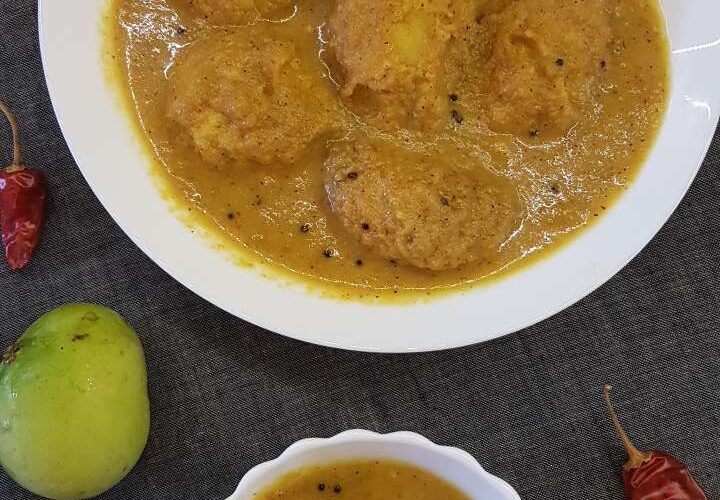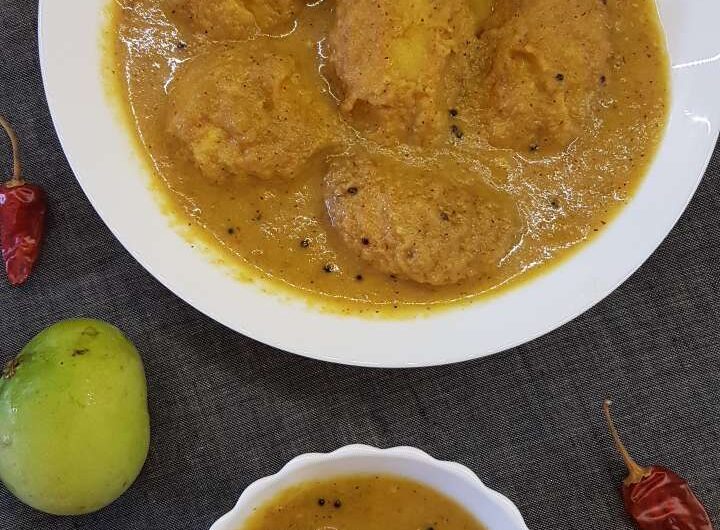Ghotache Sasav recipe with step-by-step photos and instructions. Ghotache Sasav is a sweet, sour and spicy ripe mango curry. A quick and easy recipe that is ready under 30 minutes!
Sweet Mango Curry | Ripe Mango Curry | Mango Sasav Recipe Goan-Style | Ambyache Sasav Recipe
Ghotache sasav is a traditional Konkani dish from the west coast of India. During the summers, when mangoes are abundant, ghotache sasav is one of those recipes that keep your taste buds tantalized.
Why you ask? This is primarily because Ghotache Sasav has all the 3 S‘s in it. It is Sweet, Sour and Spicy.
Konkani cuisine is rich and diverse. It mirrors the cultural and culinary traditions of the Konkani people. Although seafood is a highlight of Konkani cuisine, there are also many vegetarian dishes that are popular.
Konkani cuisine can spin a dish with minimal spices and yet give you a flavourful dish like this ghotache sasav.
Aromatic spices, such as coriander seeds, turmeric, red chillies etc. are used in different combinations in the Konkani cuisine to create a plethora of flavours and textures.
What is Ghotache Sasav/Ripe Mango Curry?
In Konkani, ‘Ghota‘ means small ripe mangoes and ‘Sasava‘ implies mustard seeds. Hence, Ghotache Sasav means Mango Mustard Curry! It is a coconut-based curry where mustard seeds are a key ingredient that impart the curry a distinct flavour.
These sweet-sour baby mangoes make a perfect appetizing curry.
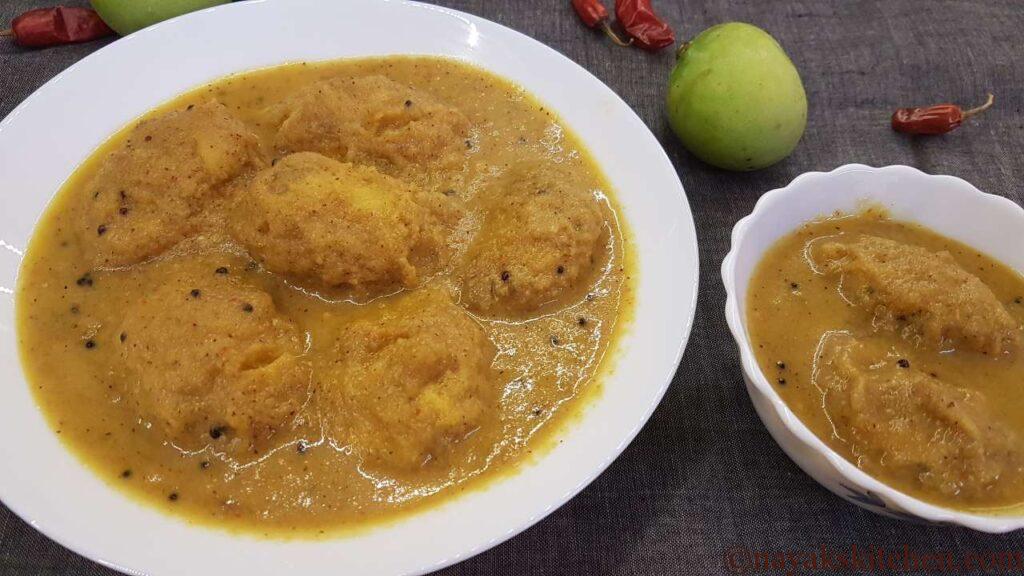
This sweet mango curry will satisfy all your cravings as it is sweet, sour and spicy. Ambyache Sasav is my favourite during the summers as it can be served as a curry or even a dessert.
Although this goan mango curry is prepared using small baby mangoes, I sometimes prepare it using regular mangoes. Especially if the mangoes are sour. I just dislike sour mangoes. So I prepare this sasav instead.
The goan mango sasav recipe is a popular flavour-packed dish, especially along the coastal belt in regions of Goa, Karnataka, and Maharashtra. It is prepared in most of the households in Goa during the mango season.
In Konkani culture, ghotache sasav is a staple and is often served during special occasions such as weddings and religious festivals.
Ghota (Small ripe mangoes)
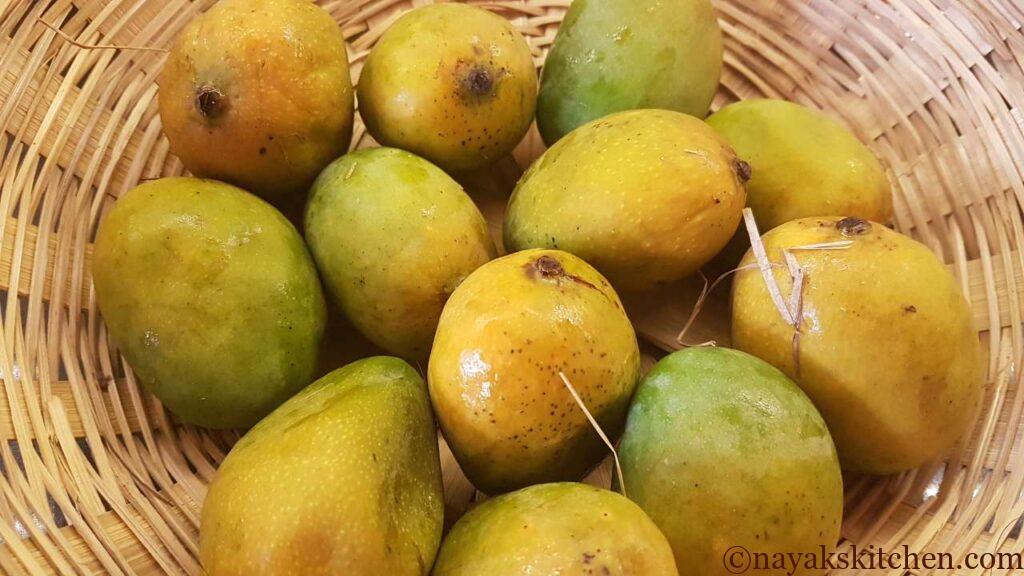
Ghota are small ripe mangoes which are greenish-yellow in colour when ripe. These small baby mangoes are very juicy and fibrous. Since they are very small compared to regular mangoes they are usually never sliced and eaten. These are mostly eaten by sucking on them.
Different variations of this recipe can be found in different regions. There are 2 types, the cooked and the uncooked one. However, the uncooked version is perishable, has a short shelf life and needs to be consumed immediately.
Also, dried prawns are added as a variation to this recipe. Moreover, this is a no-onion no-garlic recipe.
Ghota are sometimes very sweet or a mix of sweet-sour taste. For ghotache sasav, the sweet-sour ones are the best.
Sucking these small ripe mangoes is a popular way to enjoy this sweet and tangy fruit in many cultures.
How to eat Ghota?
If you have never tried eating these small mangoes directly then read on further, else just move on to the next section. Although this can be a bit messy with all the juice trickling on your hands its fun to enjoy a mango this way.
- Choose a small ripe mango that has a sweet ripe aroma and is also soft to touch.
- Wash the mango well with water.
- Gently press it with your fingers to soften the pulp inside.
- Make a small hole on the top of the mango where the stem was attached.
- Squeeze the mango with your fingers to loosen the pulp inside.
- Keep squeezing and sucking the juice simultaneously.
- Enjoy!
Ingredients for Ghotache Sasav/Ripe Mango Curry
Here is a list of some of the main ingredients you will need for the mango sasav recipe:-
- Ghota (Small ripe mangoes)
- Mustard seeds
- Fenugreek seeds (Methi seeds)
- Freshly grated coconut
- Red chillies
- Turmeric
- Asafoetida (Preferably Shankar Chaap Hing)
- Jaggery
Tips
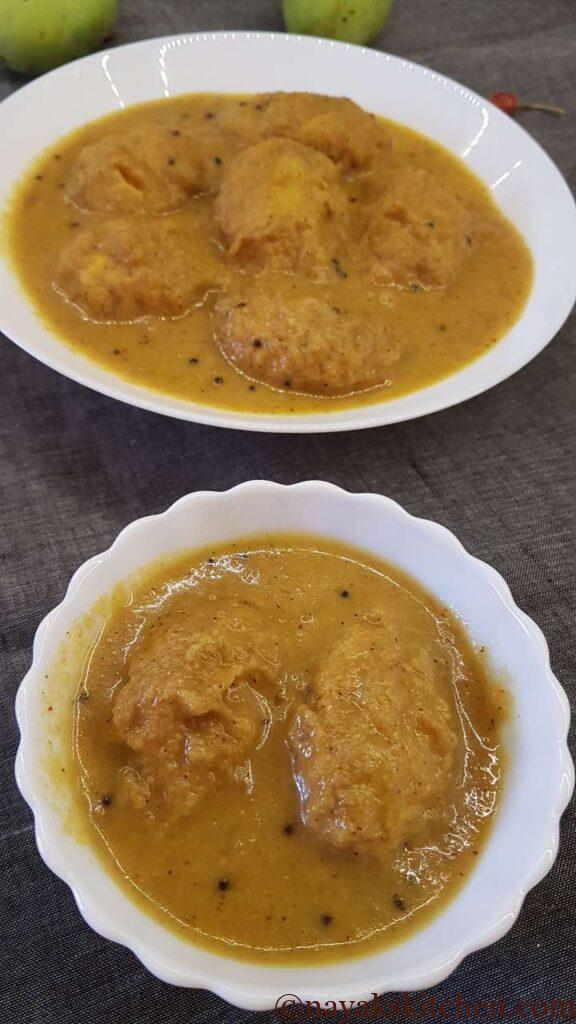
- Small mangoes (Ghota) – Preferably use the sweet-sour types. This will give you a well-balanced curry. The mangoes have to be pulpy for a mushy sasav.
- Mustard seeds – This is the key ingredient that adds the distinct flavour. However, be careful not to burn the mustard seeds as this will impart a bitter flavour to the mango curry.
- Grated Coconut – Use freshly grated coconut for this sweet mango curry recipe. Do not use desiccated coconut.
- Coconut Oil – Coconut oil imparts an authentic and traditional flavour to this curry. If not available you can use any neutral oil. Do not use mustard oil as it is very strong and will overpower the taste.
- Asafoetida (Hing) – I have used ‘Shankar Chaap’ hing. ‘Shankar Chaap‘ refers to the brand name. If you ask a shopkeeper to give you Shankar Chaap Hing he will give you pieces of this dried hing (see pic at the end). This hing is a bit more expensive than the compounded hing powders but its flavour is very intense. Also, a very small piece of it is enough to provide a heavenly aroma to the recipe. However, you can use regular powdered hing instead.
- Curry leaves – I do not use curry leaves while tempering the sasav. This is because curry leaves have a strong flavour of their own which will mask the flavour of mustard seeds.
- Jaggery – Adjust the quantity as per the sweetness and sourness of your mangoes.
- Tamarind – If your mangoes are too sweet, add a very small piece of tamarind to give a hint of tang to the recipe. However, do not add if your mangoes are sour.
- Consistency – The consistency of this ripe mango curry should be slightly thicker than any other regular curry.
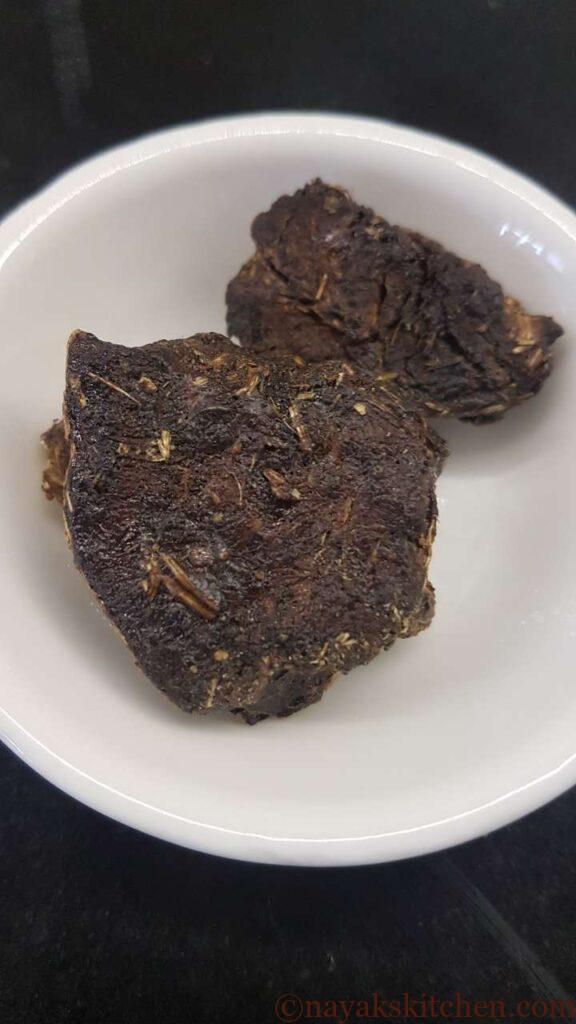
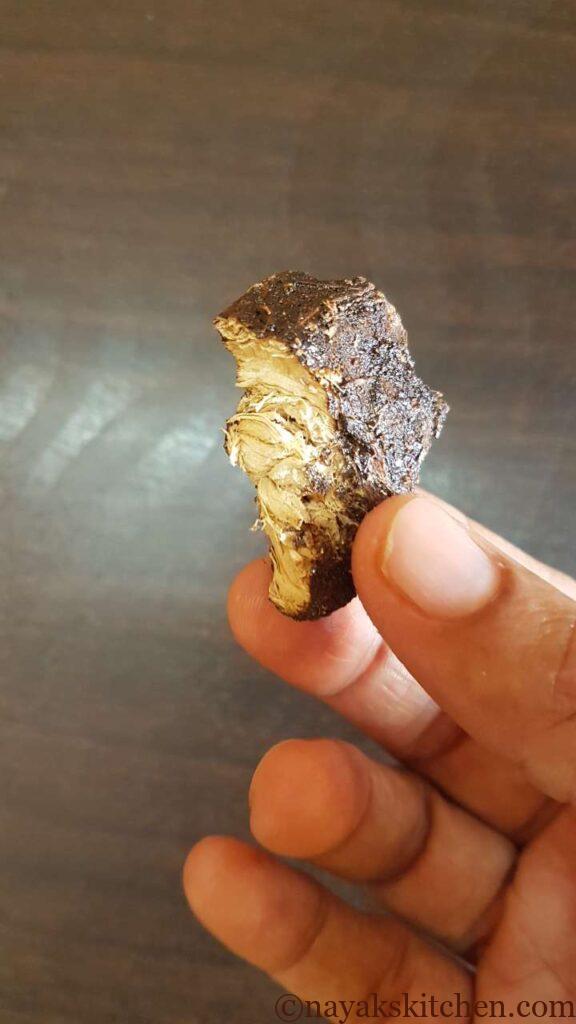
Serving Suggestions
Ghotache sasav is a versatile dish since it can be enjoyed as an accompaniment or with a variety of accompaniments.
It is usually served with steamed rice. Rice is perfect for the bold and spicy flavours of the curry. You can also pair it with jeera rice.
It can also be served with any Indian flatbreads like roti, chapati, poori, bhakri or phulkas. These have a soft texture that goes well with sasav.
You can serve it as a side dish. And lastly, you can enjoy this lip-smacking sweet mango curry as a dessert on its own too.
How to make Ghotache Sasav?
Preparing the mangoes for the ripe mango curry
- Wash the ghota or mangoes well with water. Peel them and remove the skin completely.
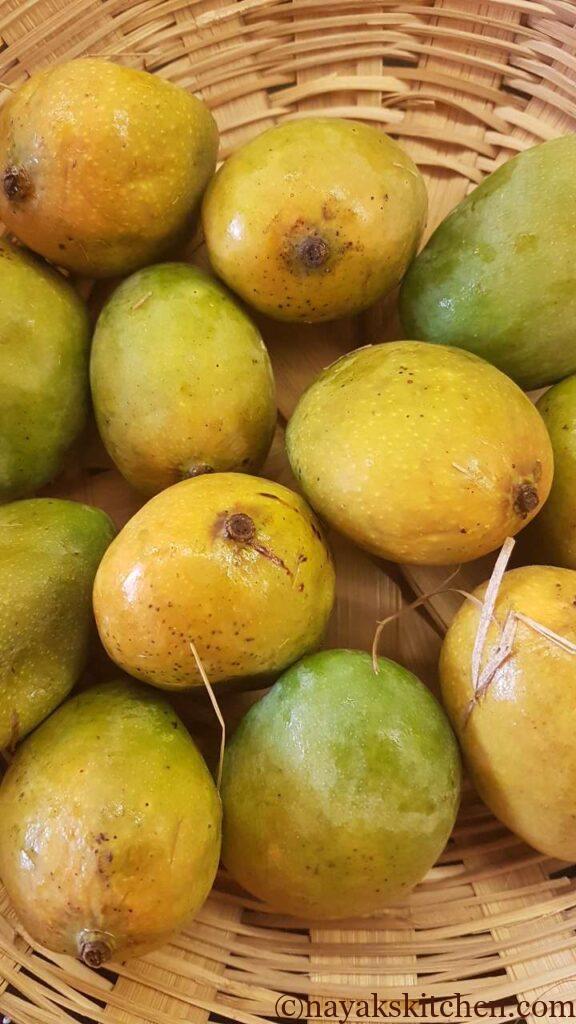
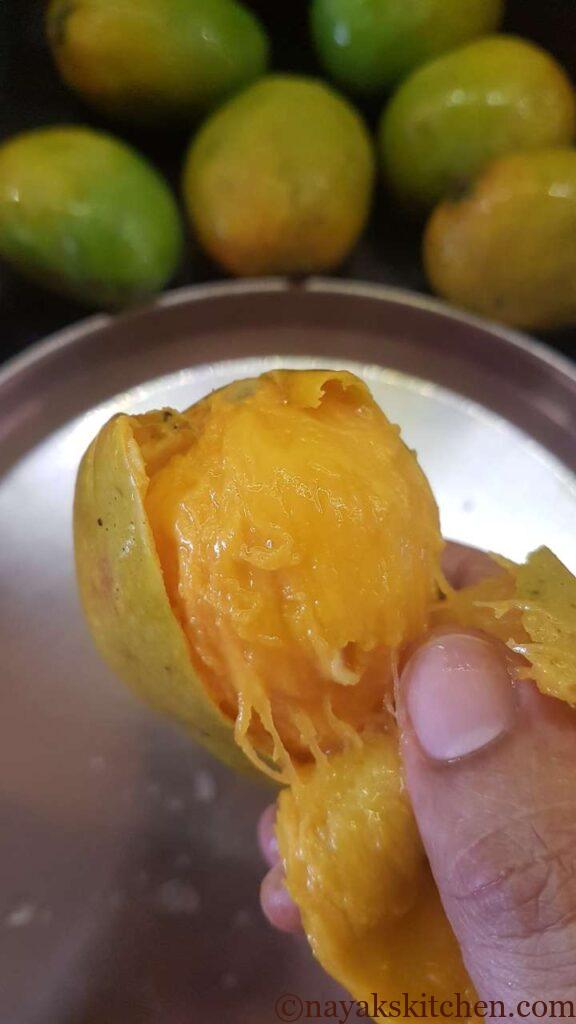
2. Once peeled, squeeze out the pulp partially. Keep the mango seed along with the pulp in a bowl.

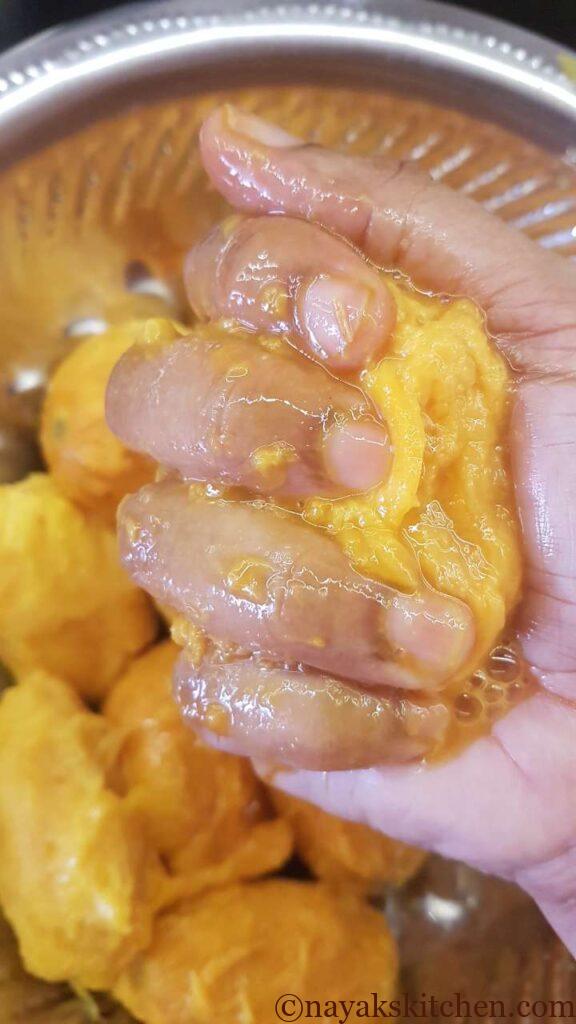
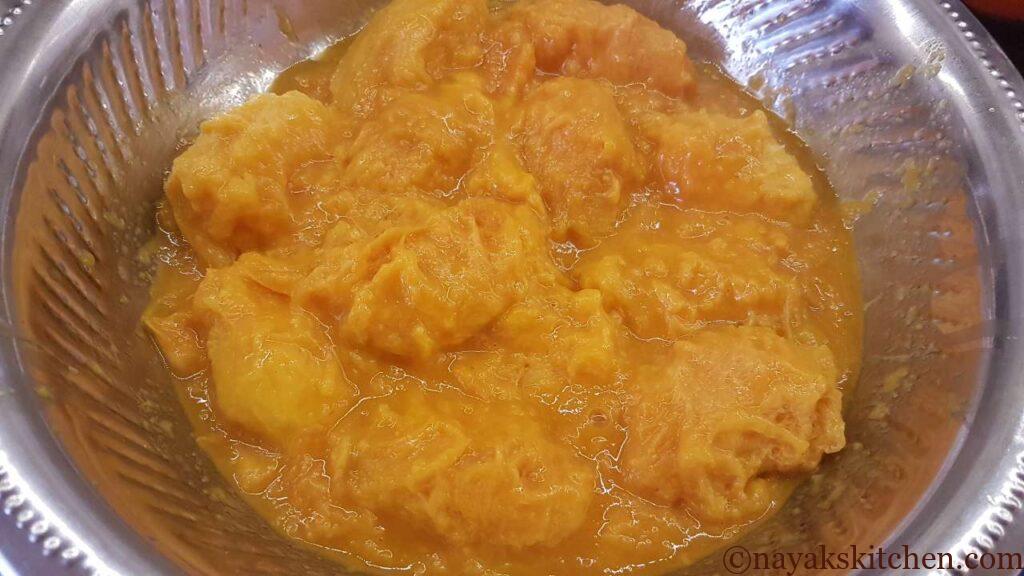
Roasting mustard seeds
1. Heat a tempering pan (tadka pan) or a kadhai. Add 1/2 tsp of mustard seeds to it and dry roast on low flame for about a minute. Do not burn the mustard seeds. Once roasted remove and keep aside.
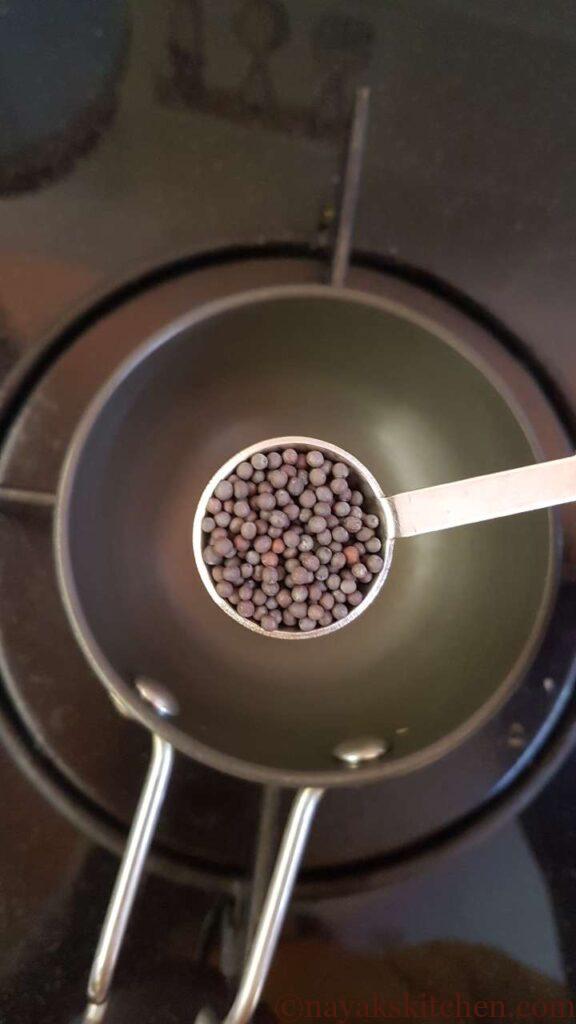
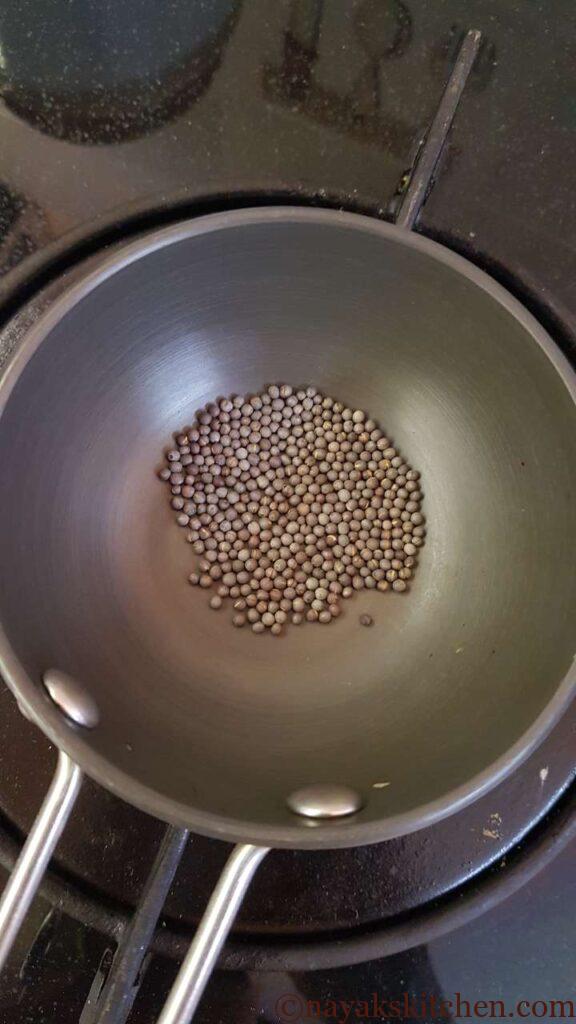
Roasting Asafoetida
Roast the asafoetida only if you are using raw hing in its dried gum form. You need not roast readymade powdered hing.
1. To the same pan, add a pinch of asafoetida (hing). Dry roast on low flame for about a minute. Remove and take it in a mortar-pestle.
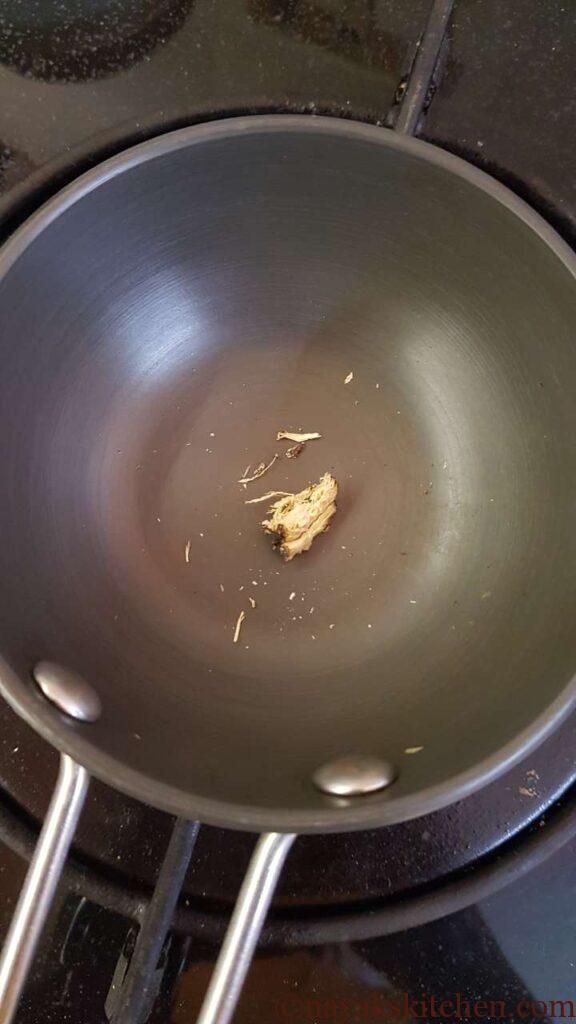
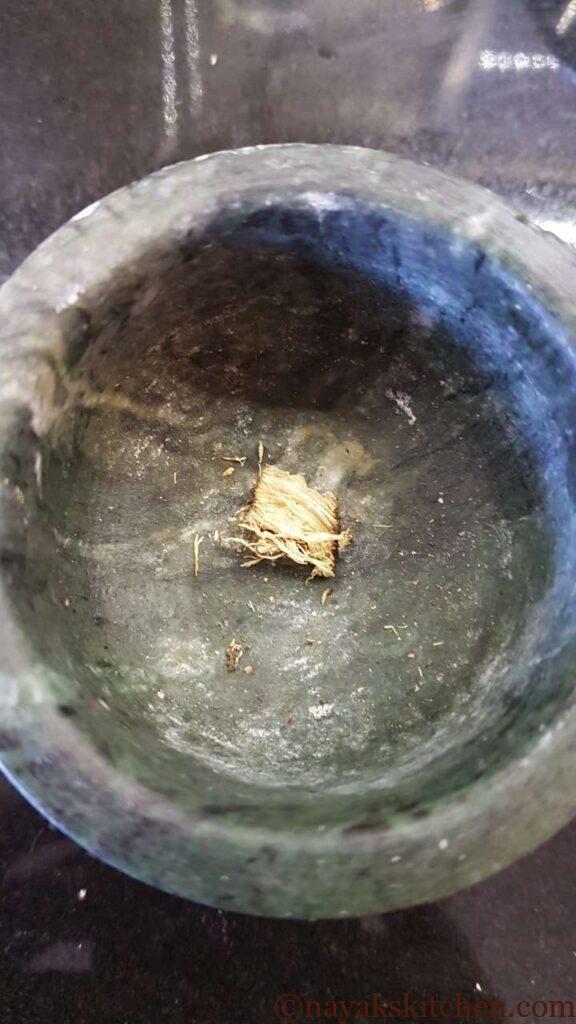
2. Crush the asafoetida and pound it to a powder. Keep aside.
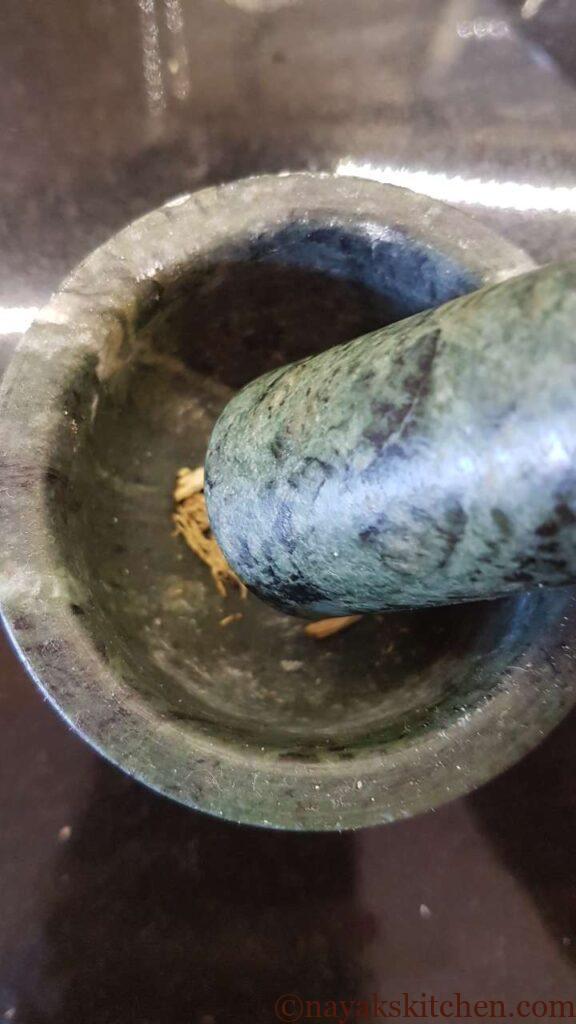
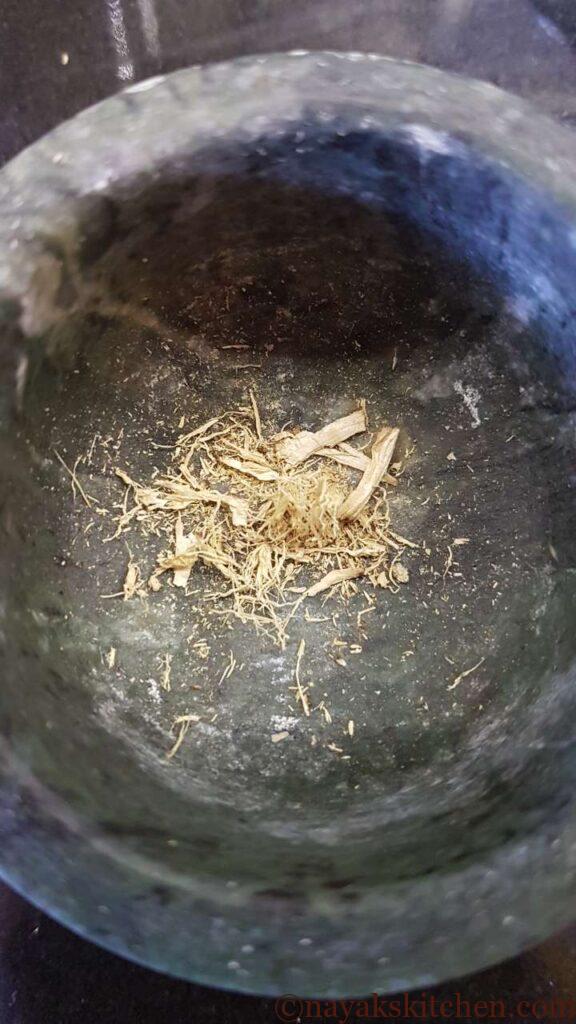
Grinding the coconut paste
- Take the grated coconut, red chillies, turmeric powder and roasted mustard seeds in a mixie and grind to a slightly coarse paste. Do not make the paste very fine.
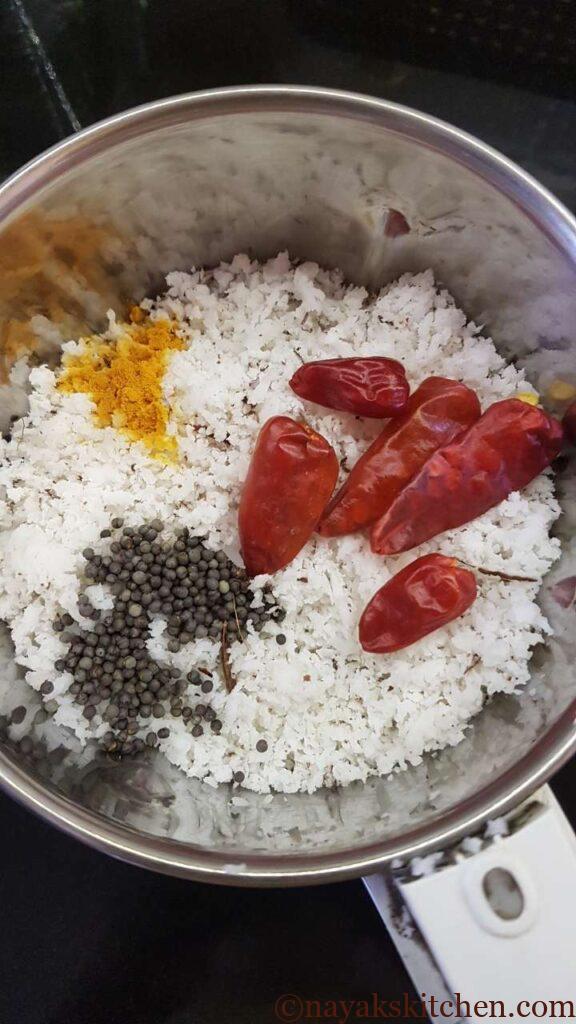
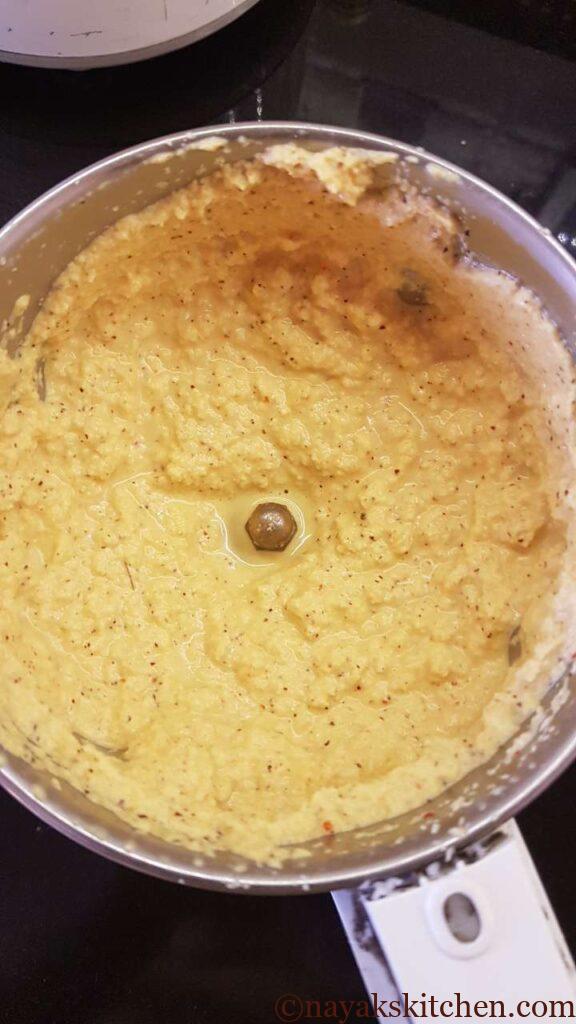
Preparing Ghotache Sasav
- Heat coconut oil (or any other neutral-tasting oil) in a kadhai (wok). Add mustard seeds and fenugreek seeds.
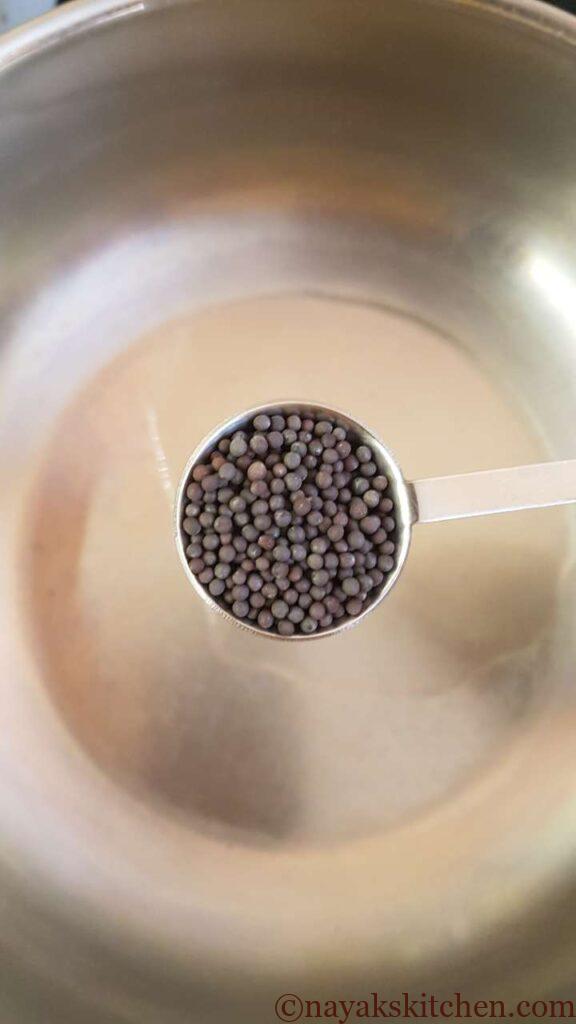
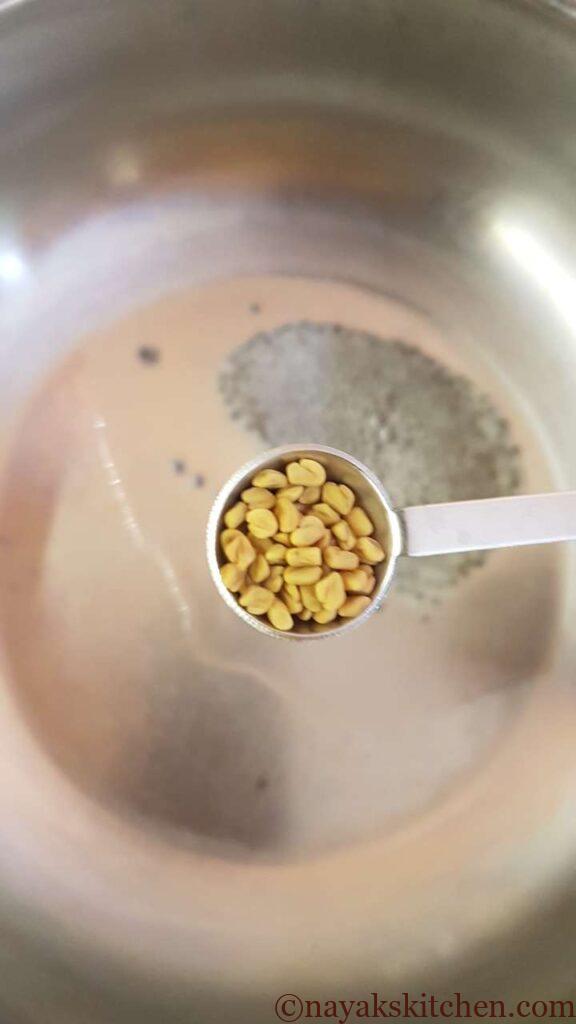
2. When the mustard seeds splutter, add asafoetida (hing).
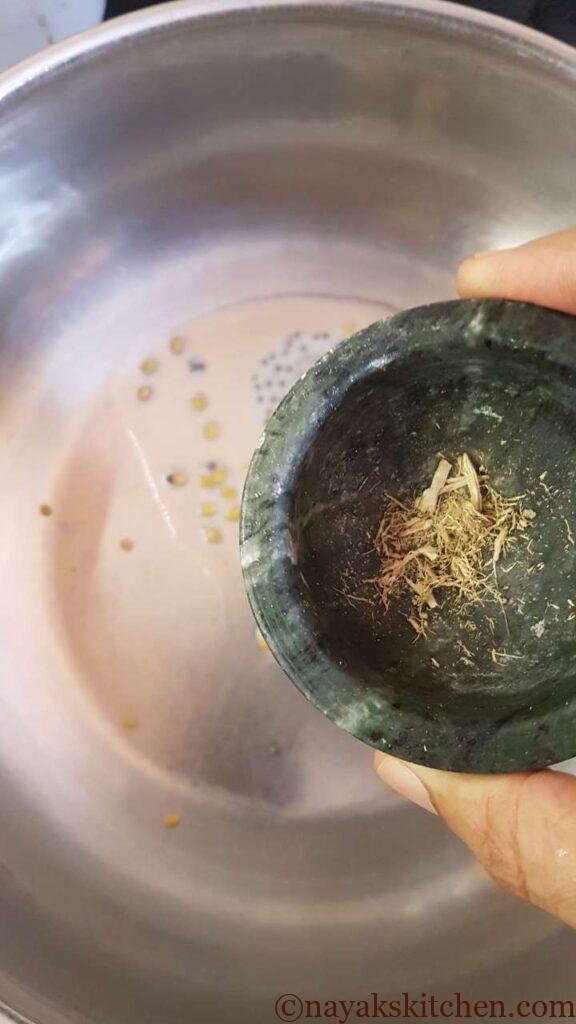
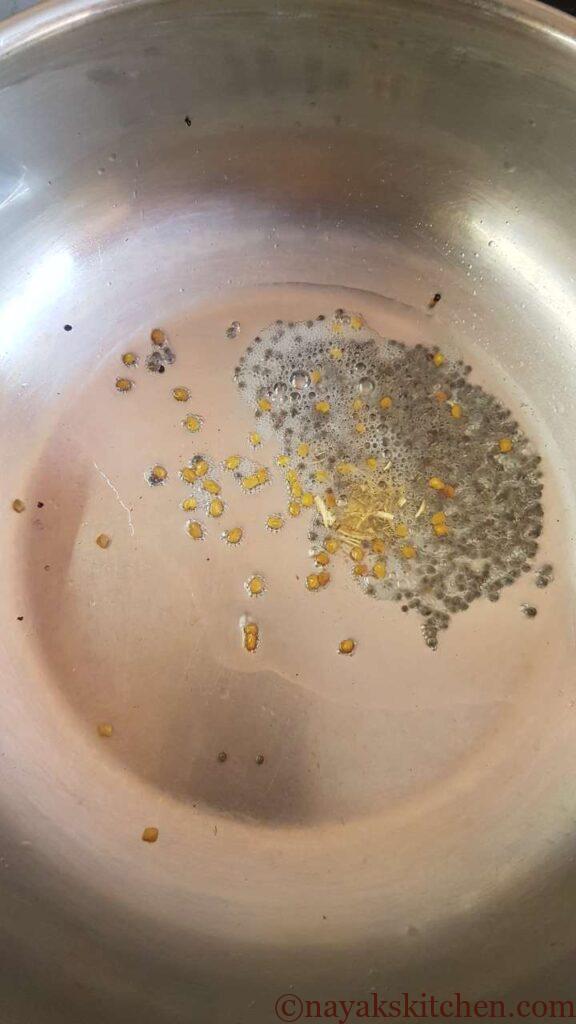
3. Add the mangoes with the pulp.
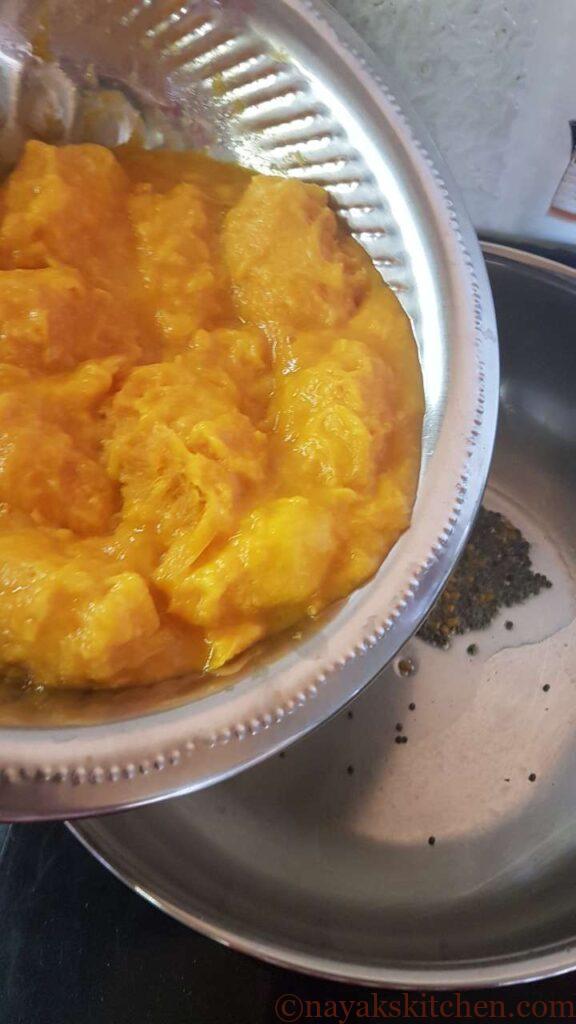
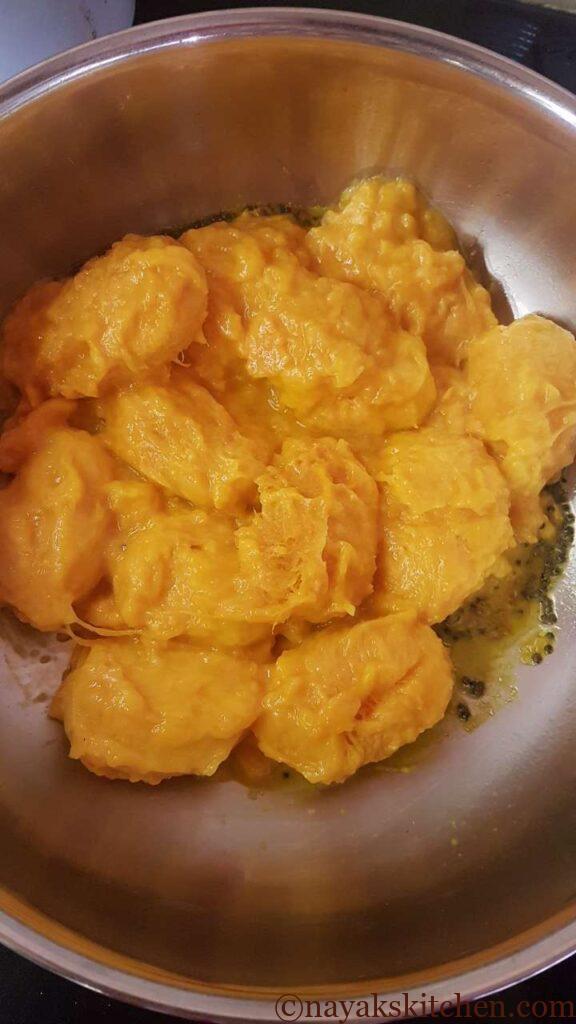
4. Add 1/2 cup water, mix well and cook covered for 2 mins.
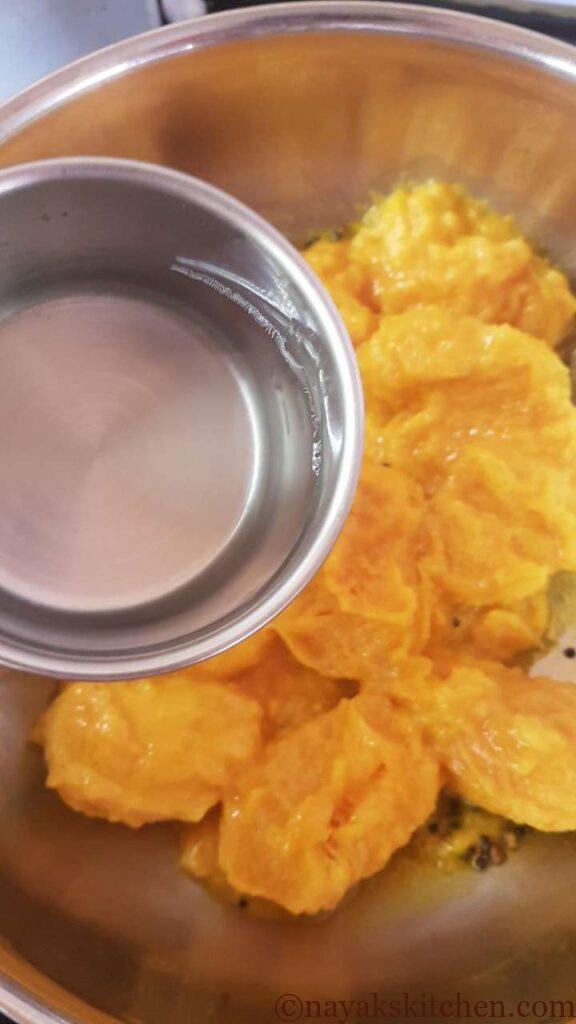
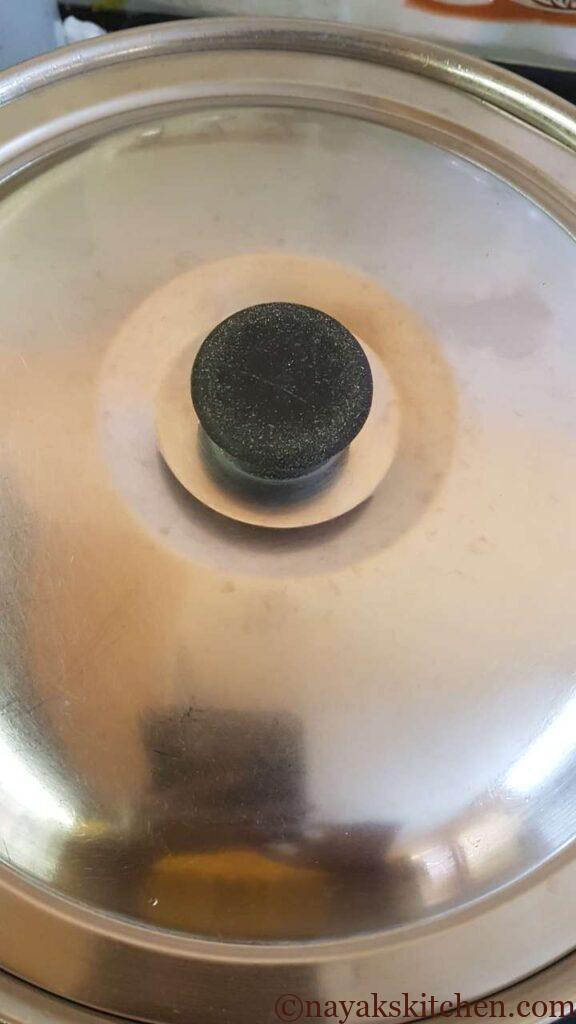
5. Once the mangoes are cooked add the ground masala paste.
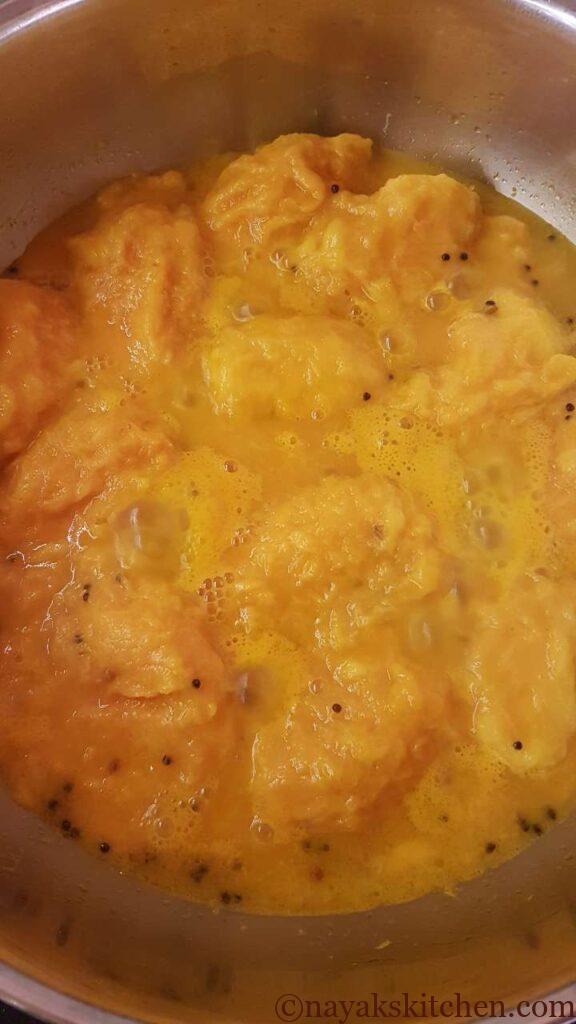
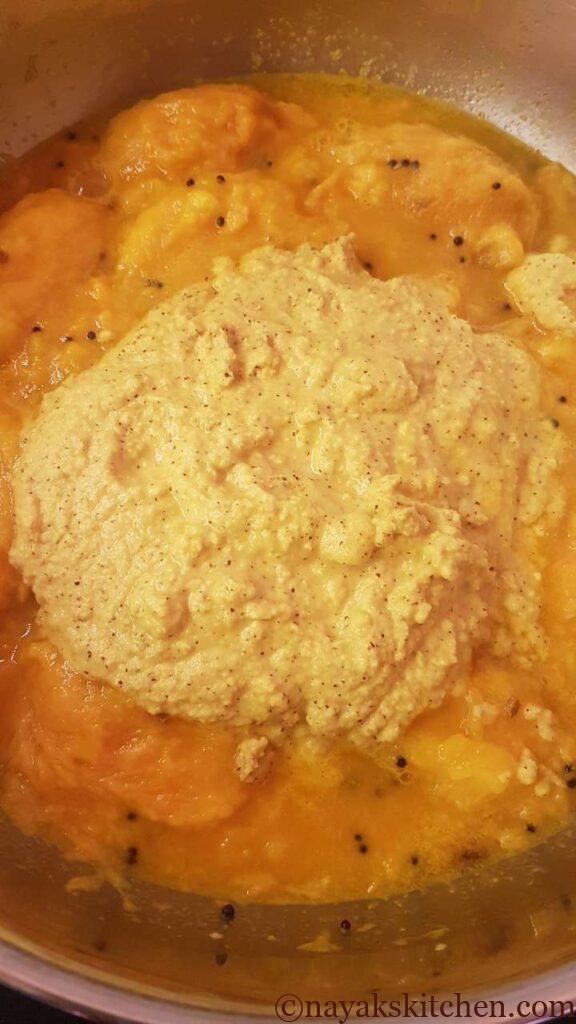
6. Mix everything well. Add 1/2 cup water to adjust the consistency. Ghota Sasav should be slightly thicker than other regular curries.


7. Add salt as per taste.

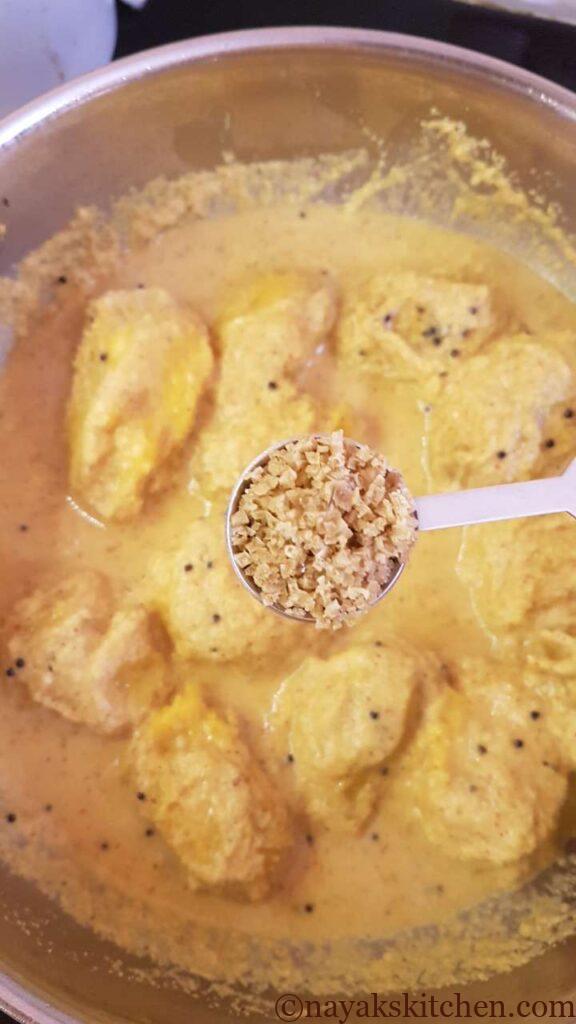
8. Add jaggery as per the sweetness of the mangoes. I have used half cup as my ghota were neither too sweet nor too sour. If the mangoes are too sour add more jaggery. However, if they are very sweet add less jaggery. Balance the sweet-sour-spicy taste.
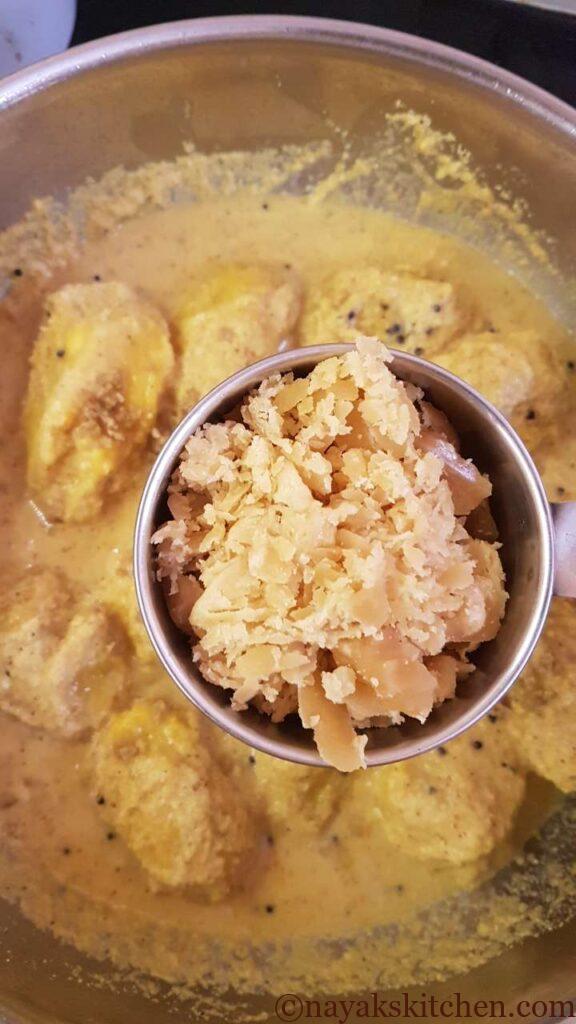
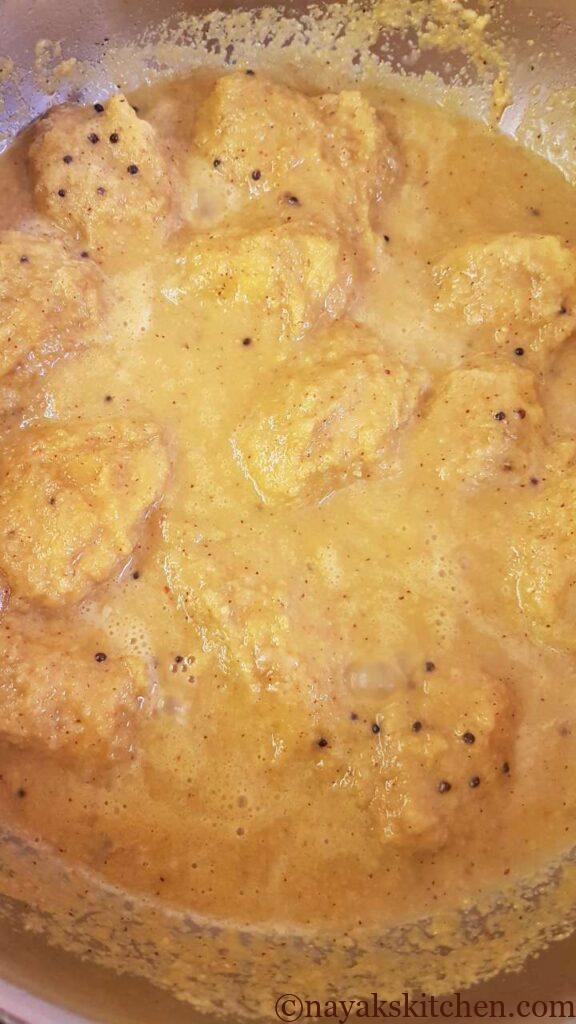
9. Serve Ghotache Sasav with steamed rice or any Indian flatbread of your choice or just enjoy it as a dessert on its own.

Do try out the Ghotache Sasav and let me know in the comments section.
Follow me on Instagram, Facebook and Pinterest. Tag me on Instagram @nayakskitchen and upload your tried recipe photos at #nayakskitchen. I would love to see them. Happy Cooking!
Ghotache Sasav | How to make Goan Mango Sasav?
Course: Side Dish, Vegetarian CurryCuisine: KonkanDifficulty: EasyGhotache Sasav is a sweet, sour and spicy ripe mango curry.
Ingredients
1 cup = 250 ml
1 tbsp = 15 ml
1 tsp = 5 ml
Ghotan (small ripe baby mangoes) – 10-12 nos.
Water – 1/2 cup (to cook the mangoes)
- For the masala paste
Grated Coconut – 1 cup
Mustard seeds – 1/2 tsp
Red chillies – 4-5 nos.
Turmeric powder – a pinch
- For Tempering
Mustard – 1 tsp
Fenugreek seeds (methi seeds) – 1/4 tsp
Asafoetida (hing) – a pinch
Oil – 1 tbsp (preferably coconut oil)
- Other ingredients
Jaggery – 1/2 cup
Salt – 1 tsp (or as per taste)
Water – 1/2 cup (to adjust consistency)
Directions
- Preparing the mangoes
- Wash the ghota or mangoes well with water. Peel them and remove the skin completely.
- Once peeled, squeeze out the pulp partially. Keep the mango seed along with the pulp in a bowl.
- Roasting mustard seeds
- Heat a tempering pan (tadka pan) or a kadhai. Add 1/2 tsp of mustard seeds to it and dry roast on low flame for about a minute. Do not burn the mustard seeds. Once roasted remove and keep aside.
- Roasting asafoetida
- (Roast the asafoetida only if you are using raw hing in its dried gum form. You need not roast readymade powdered hing.)
- To the same pan, add a pinch of asafoetida (hing). Dry roast on low flame for about a minute. Remove and take it in a mortar-pestle.
- Crush the asafoetida and pound it to a powder. Keep aside.
- Grinding the coconut paste
- Take the grated coconut, red chillies, turmeric powder and roasted mustard seeds in a mixie and grind to a slightly coarse paste. Do not make the paste very fine.
- Preparing Ghotache Sasav
- Heat coconut oil (or any other neutral-tasting oil) in a kadhai (wok). Add mustard seeds and fenugreek seeds.
- When the mustard seeds splutter, add asafoetida (hing).
- Add the mangoes with the pulp.
- Add 1/2 cup water, mix well and cook covered for 2 mins.
- Once the mangoes are cooked add the ground masala paste.
- Mix everything well. Add 1/2 cup water to adjust the consistency. Ghota Sasav should be slightly thicker than other regular curries.
- Add salt as per taste.
- Add jaggery as per the sweetness of the mangoes. Balance the sweet-sour-spicy taste.
- Serve Ghotache Sasav with steamed rice or any Indian flatbread of your choice or just enjoy it as a dessert on its own.
Notes
- Small mangoes (Ghota) – Preferably use the sweet-sour types. This will give you a well-balanced curry. The mangoes have to be pulpy for a mushy sasav.
- Mustard seeds – This is the key ingredient that adds the distinct flavour. However, be careful not to burn the mustard seeds while roasting as this will impart a bitter flavour to the mango curry.
- Grated Coconut – Use freshly grated coconut for this sweet mango curry recipe. Do not use desiccated coconut.
- Coconut Oil – Coconut oil imparts an authentic and traditional flavour to this curry. If not available you can use any neutral oil. Do not use mustard oil as it is very strong and will overpower the taste.
- Asafoetida (Hing) – I have used ‘Shankar Chaap’ hing. ‘Shankar Chaap‘ refers to the brand name. If you ask a shopkeeper to give you Shankar Chaap Hing he will give you pieces of this dried hing (see pic at the end). This hing is a bit more expensive than the compounded hing powders but its flavour is very intense. Also, a very small piece of it is enough to provide a heavenly aroma to the recipe. However, you can use regular powdered hing instead if not available.
- Curry leaves – I do not use curry leaves while tempering the sasav. This is because curry leaves have a strong flavour of their own which will mask the flavour of mustard seeds.
- Jaggery – Adjust the quantity as per the sweetness and sourness of your mangoes. I have used half cup as my ghota were neither too sweet nor too sour. If the mangoes are too sour add more jaggery. However, if they are very sweet add less jaggery.
- Tamarind – If your mangoes are too sweet, add a very small piece of tamarind to give a hint of tang to the recipe. However, do not add if your mangoes are sour.
- Consistency – The consistency of this ripe mango curry should be slightly thicker than any other regular curry.
Other Vegetarian Curries
Do try out these other vegetarian curries at Nayakskitchen.
Alsane Tonak (Red Cow Peas Curry)
Kaju Tonak (Tender Cashew Curry)
Masoor Tonak (Brown lentils Curry)
Muga Gathi (Sprouted Green Gram Curry)





